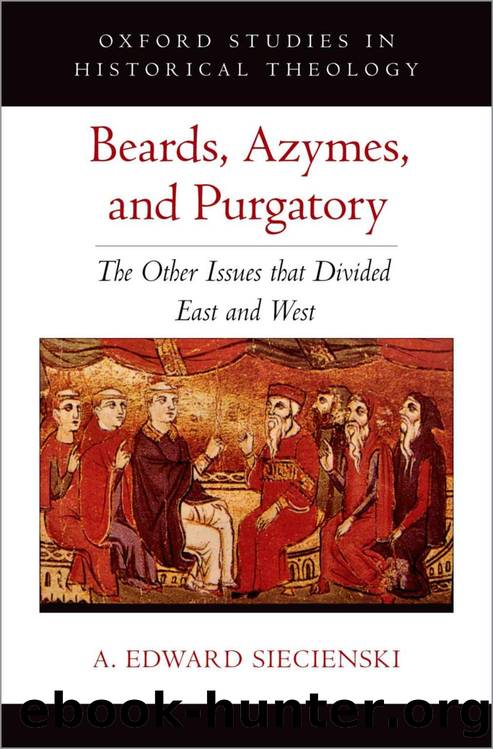Beards, Azymes, and Purgatory (OXFORD STU IN HISTORICAL THEOLOGY SERIES) by A. Edward Siecienski

Author:A. Edward Siecienski [Siecienski, A. Edward]
Language: eng
Format: epub
Publisher: Oxford University Press
Published: 2022-08-29T16:00:00+00:00
Part III
Purgatory
6
Purgatory in the Biblical and Patristic Tradition
According to Jacques Le Goff, the word âPurgatoryâ did not appear as a noun until sometime between 1170 and 1180, a fact used for centuries by critics, both Orthodox and Protestant, who claimed that the dogma had no biblical and patristic basis.1 Yet Catholic authors since the Middle Ages have maintained that although the word âPurgatoryâ itself is not present, the teaching that departed souls can be cleansed of their sins after death is âexplicitly taught in Scripture ⦠found in the writings of the early church fathers ⦠[and] is part of the deposit of faith âwhich was once for all delivered to the saintsâ (Jude 1:3).â2 The Orthodox, while acknowledging the importance of prayers for the dead, remained unconvinced by this argument, and interpreted the writings of certain fathers (e.g., Gregory of Nyssa) on âthe crucible of purifying fireâ differently than their Catholic counterparts.3 Protestants went even further, rejecting not only the doctrine of Purgatory, but also (to varying degrees) all prayers for the deceased.4
The question of Purgatory, and the extent to which it is treated in both the biblical and patristic corpus, is intimately bound up with the larger question about the state of souls after death and how the early church thought about the issue. Christianity has always been an eschatological faith, with Christians holding that âthe end was near ⦠because they believed Jesus had risen from the dead, and because they were convinced that the communityâs new experience of the charisms of the Spirit was the first taste of the Kingdom of God.â5 Yet as time passed and the timeline for the eschaton shifted, questions arose about the fate of those who had died and a more developed eschatological system was needed. One can see the beginnings of this process in Paul (e.g., 1 Thes 4:13â18),6 but it would take centuries before many of the questions Christians had about the next world received doctrinal formulation. Purgatory arose out of this conversation, with writers searching the Scriptures for hints of what happened after death, how sins committed after baptism were forgiven, and how the church on earth was linked in prayer to those who had gone before.
Certain biblical texts lent themselves to this discussion, and these would become the battleground in the fight over Purgatory for the next thousand years: 2 Maccabees 12:39â45, Matthew 12:32, Revelation 21:27, and 1 Corinthians 3:11â15 would be the chief prooftexts used by the Latins, bolstered by other passages (like Dt 25:2, Ez 33:14â15, Ws 7:25,) that dealt with punishment, forgiveness, and the necessity of purity upon entrance to the kingdom. Still later other New Testament textsâMatthew 5:25â26, Luke 12:47â48, 1 Corinthians 15:28â29, Hebrews 12:22â23âwould be employed by defenders of the doctrine who hoped to ground the teaching in the words of Jesus and Paul.
As the church fathers continued to explore these questions, they were guided by several factors, including not only the Scriptures, but also their understanding of the universe and the pastoral needs of those to whom they wrote.
Download
This site does not store any files on its server. We only index and link to content provided by other sites. Please contact the content providers to delete copyright contents if any and email us, we'll remove relevant links or contents immediately.
Signature in the Cell: DNA and the Evidence for Intelligent Design by Stephen C. Meyer(3070)
Real Sex by Lauren F. Winner(2965)
The Secret Power of Speaking God's Word by Joyce Meyer(2964)
The Holy Spirit by Billy Graham(2892)
The Gnostic Gospels by Pagels Elaine(2468)
Jesus by Paul Johnson(2309)
Devil, The by Almond Philip C(2279)
23:27 by H. L. Roberts(2195)
The Nativity by Geza Vermes(2178)
Chosen by God by R. C. Sproul(2122)
All Things New by John Eldredge(2102)
Angels of God: The Bible, the Church and the Heavenly Hosts by Mike Aquilina(1932)
The Return of the Gods by Erich von Daniken(1894)
Angels by Billy Graham(1886)
Knowing God by J.I. Packer(1804)
Jesus of Nazareth by Joseph Ratzinger(1766)
Evidence of the Afterlife by Jeffrey Long(1744)
The Gnostic Gospel of St. Thomas by Tau Malachi(1736)
How To Be Born Again by Billy Graham(1730)
